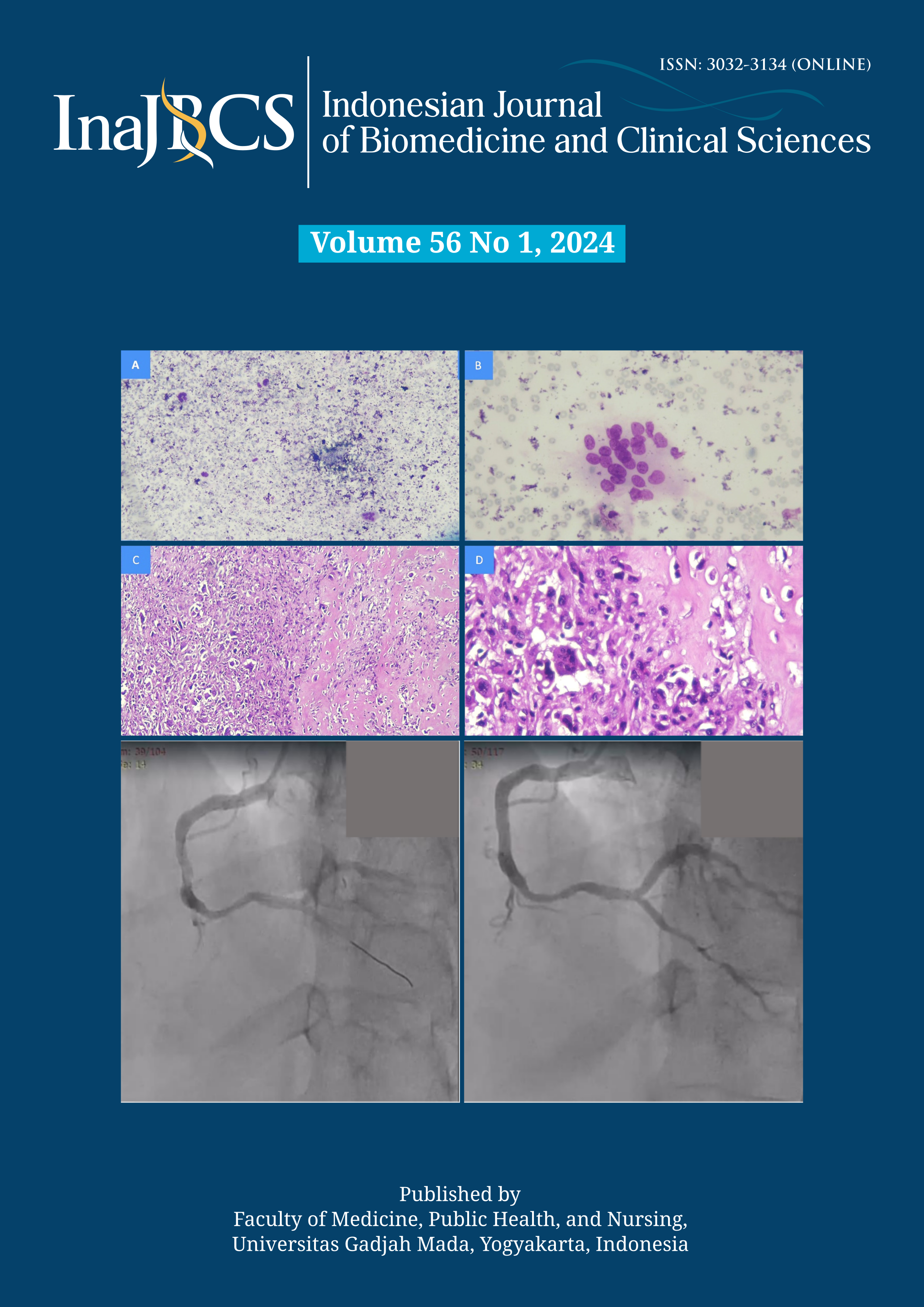Reversible total atrioventricular block in a very high-risk non-ST-elevation myocardial infarction (NSTEMI) during conservative treatment in a limited resource setting: a case report
Abstract
Total atrioventricular (AV) block is the most common type of conduction disorder found in acute coronary syndrome (ACS), which requires timely recognition and treatment. This case report aimed to present conservative medical treatment for managing total AV block (TAVB) in a very high-risk non-ST-elevation myocardial infarction (NSTEMI) in a rural area. We reported a patient with TAVB in a very high-risk NSTEMI. The patient was hemodynamically unstable and needed immediate percutaneous coronary intervention (PCI). Due to limited facilities and difficult access to immediate PCI, the patient was treated conservatively with the NSTEMI protocol. Epinephrine, as a β-adrenergic agonist, was administered to improve hemodynamic status. During conservative treatment, TAVB was converted into the first-degree AV block on the third day of intensive care. In a setting where revascularization strategies and pacemaker implantation are not feasible, administration of antithrombotic agents and β-adrenergic agonists can be considered to manage TAVB with NSTEMI with close monitoring.
References
Aguiar Rosa S, Timóteo AT, Ferreira L, Carvalho R, Oliveira M, Cunha P, et al. Complete atrioventricular block in acute coronary syndrome: prevalence, characterisation and implication on outcome. Eur Hear J Acute Cardiovasc Care 2018; 7(3):218-23.
https://doi.org/10.1177/2048872617716387
Hashmi KA, Shehzad A, Hashmi AA, Khan A. Atrioventricular block after acute myocardial infarction and its association with other clinical parameters in Pakistani patients: an institutional perspective. BMC Res Notes 2018; 11(1):329.
https://doi.org/10.1186/s13104-018-3431-5
Singh SM, FitzGerald G, Yan AT, Brieger D, Fox KAA, López-Sendón J, et al. High-grade atrioventricular block in acute coronary syndromes: insights from the Global Registry of Acute Coronary Events. Eur Heart J 2015; 36(16):976-83.
https://doi.org/10.1093/eurheartj/ehu357
Santos H, Santos M, Almeida I, Paula SB, Chin J, Almeida S, et al. High-grade atrioventricular block in acute coronary syndrome: Portuguese experience. J Electrocardiol 2021; 68:130-4.
https://doi.org/10.1016/j.jelectrocard.2021.08.002
Misumida N, Ogunbayo GO, Kim SM, Abdel-Latif A, Ziada KM, Elayi CS. Frequency and significance of high-degree atrioventricular block and sinoatrial node dysfunction in patients with non-ST-elevation myocardial infarction. Am J Cardiol 2018; 122(10):1598-603.
https://doi.org/10.1016/j.amjcard.2018.08.001
Shah SP, Waxman S. Two cases of Bezold-Jarisch reflex induced by intra-arterial nitroglycerin in critical left main coronary artery stenosis. Texas Hear Inst J 2013; 40(4):484-6.
Yuan KM, Fu SY, Li J, Shangguan WN, Lian QQ. Bezold-Jarisch reflex occurred in a pediatric patient with giant intra-abdominal teratoma during induction of anesthesia: A case report. Medicine (Baltimore) 2017; 96(41):e8304.
https://doi.org/10.1097/MD.0000000000008304
Wei S, Zhong L, Chen S, Li X. The status of coronary artery lesions in patients with conduction disturbance. J Cardiovasc Med (Hagerstown) 2011; 12(10):709-13.
https://doi.org/10.2459/JCM.0b013e328349187c
Yesil M, Arikan E, Postaci N, Bayata S, Yilmaz R. Locations of coronary artery lesions in patients with severe conduction disturbance. Int Heart J 2008; 49(5):525-31.
https://doi.org/10.1536/ihj.49.525
Kusumoto FM, Schoenfeld MH, Barrett C, Edgerton JR, Ellenbogen KA, Gold MR, et al. 2018 ACC/AHA/HRS guideline on the evaluation and management of patients with bradycardia and cardiac conduction delay: a report of the American College of Cardiology/American Heart Association Task Force on Clinical Practice Guidelines and the Heart Rhythm Society. Circulation 2019; 140(8):e382-482.
https://doi.org/10.1161/CIR.0000000000000628
Cardoso R, Alfonso CE, Coffey JO. Reversibility of high-grade atrioventricular block with revascularization in coronary artery disease without infarction: a literature review. Case Rep Cardiol 2016; 2016:1971803.
https://doi.org/10.1155/2016/1971803
Hwang IC, Seo WW, Oh IY, Choi EK, Oh S. Reversibility of atrioventricular block according to coronary artery disease: results of a retrospective study. Korean Circ J 2012; 42(12):816-22.
https://doi.org/10.4070/kcj.2012.42.12.816
Patel R, Krukowski A, Sheikh A. High degree atrioventricular block in non-ST-segment elevation myocardial infarction (NSTEMI) and role of early revascularization. Cureus 2020; 12(7):e9222.
https://doi.org/10.7759/cureus.9222
Levy B, Clere-Jehl R, Legras A, Morichau-Beauchant T, Leone M, Frederique G, et al. Epinephrine versus norepinephrine for cardiogenic shock after acute myocardial infarction. J Am Coll Cardiol 2018; 72(2):173-82.
https://doi.org/10.1016/j.jacc.2018.04.051
Sandjojo E, Jaury VA, Astari YK, Sukmana M, Haeruman RA, Kloping YP. Dopamine and epinephrine for managing complete atrioventricular block due to nonreperfused acute inferior wall myocardial infarction in a rural hospital: a case report. SAGE Open Med Case Rep 2021; 9:2050313X21996113.






